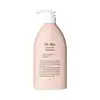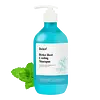What's inside
What's inside
 Key Ingredients
Key Ingredients

 Benefits
Benefits

 Concerns
Concerns

 Ingredients Side-by-side
Ingredients Side-by-side

Water
Skin ConditioningCocamidopropyl Hydroxysultaine
CleansingDisodium Laureth Sulfosuccinate
CleansingSodium C14-16 Olefin Sulfonate
CleansingGlycerin
HumectantSodium Chloride
MaskingDipropylene Glycol
HumectantHydroxyacetophenone
AntioxidantCaprylyl Glycol
EmollientPolyquaternium-10
Prunus Amygdalus Amara Kernel Oil
MaskingHaematococcus Pluvialis Extract
AntioxidantCamellia Sinensis Leaf Extract
AntimicrobialSodium Cocoyl Alaninate
Citric Acid
BufferingPyrus Malus Leaf Extract
Skin ConditioningTetradecene
EmollientHexadecene
SolventDisodium EDTA
Vanilla Planifolia Fruit Extract
Skin ConditioningJasminum Officinale Flower Water
MaskingButylene Glycol
HumectantEthylhexylglycerin
Skin Conditioning1,2-Hexanediol
Skin ConditioningRosa Centifolia Flower Water
Skin ConditioningSodium Hyaluronate
HumectantDipotassium Glycyrrhizate
HumectantEriobotrya Japonica Leaf Extract
Skin ConditioningMorus Alba Leaf Extract
Skin ConditioningLeonurus Sibiricus Extract
Skin ConditioningWater, Cocamidopropyl Hydroxysultaine, Disodium Laureth Sulfosuccinate, Sodium C14-16 Olefin Sulfonate, Glycerin, Sodium Chloride, Dipropylene Glycol, Hydroxyacetophenone, Caprylyl Glycol, Polyquaternium-10, Prunus Amygdalus Amara Kernel Oil, Haematococcus Pluvialis Extract, Camellia Sinensis Leaf Extract, Sodium Cocoyl Alaninate, Citric Acid, Pyrus Malus Leaf Extract, Tetradecene, Hexadecene, Disodium EDTA, Vanilla Planifolia Fruit Extract, Jasminum Officinale Flower Water, Butylene Glycol, Ethylhexylglycerin, 1,2-Hexanediol, Rosa Centifolia Flower Water, Sodium Hyaluronate, Dipotassium Glycyrrhizate, Eriobotrya Japonica Leaf Extract, Morus Alba Leaf Extract, Leonurus Sibiricus Extract
Water
Skin ConditioningDisodium Laureth Sulfosuccinate
CleansingLauryl Betaine
CleansingCocamide Mipa
EmulsifyingSodium Cocoyl Alaninate
Sodium Cocoyl Isethionate
CleansingC12-13 Pareth-9
EmulsifyingSodium Chloride
MaskingMenthol
MaskingLauryl Glucoside
CleansingMentha Arvensis Leaf Oil
MaskingDipropylene Glycol
Humectant1,2-Hexanediol
Skin ConditioningCitric Acid
BufferingHydroxyacetophenone
AntioxidantPanthenol
Skin ConditioningSalicylic Acid
MaskingPolyquaternium-10
Niacinamide
SmoothingTetrasodium EDTA
Mentha Suaveolens Leaf Extract
AstringentButylene Glycol
HumectantMelaleuca Alternifolia Leaf Water
AntimicrobialPropanediol
SolventPrunus Mume Fruit Extract
HumectantMalus Domestica Fruit Extract
AntioxidantCarica Papaya Fruit Extract
Skin ConditioningVitis Vinifera Fruit Extract
Skin ConditioningCyclodextrin
AbsorbentHydrolyzed Vegetable Protein
Skin ConditioningCamellia Sinensis Leaf Extract
AntimicrobialMaltodextrin
AbsorbentPentylene Glycol
Skin ConditioningThymus Vulgaris Leaf Extract
Skin ProtectingEthylhexylglycerin
Skin ConditioningCaprylyl Glycol
EmollientMadecassoside
AntioxidantHydrolyzed Soy Protein Extract
Skin ConditioningLimonene
PerfumingWater, Disodium Laureth Sulfosuccinate, Lauryl Betaine, Cocamide Mipa, Sodium Cocoyl Alaninate, Sodium Cocoyl Isethionate, C12-13 Pareth-9, Sodium Chloride, Menthol, Lauryl Glucoside, Mentha Arvensis Leaf Oil, Dipropylene Glycol, 1,2-Hexanediol, Citric Acid, Hydroxyacetophenone, Panthenol, Salicylic Acid, Polyquaternium-10, Niacinamide, Tetrasodium EDTA, Mentha Suaveolens Leaf Extract, Butylene Glycol, Melaleuca Alternifolia Leaf Water, Propanediol, Prunus Mume Fruit Extract, Malus Domestica Fruit Extract, Carica Papaya Fruit Extract, Vitis Vinifera Fruit Extract, Cyclodextrin, Hydrolyzed Vegetable Protein, Camellia Sinensis Leaf Extract, Maltodextrin, Pentylene Glycol, Thymus Vulgaris Leaf Extract, Ethylhexylglycerin, Caprylyl Glycol, Madecassoside, Hydrolyzed Soy Protein Extract, Limonene
 Reviews
Reviews

Ingredients Explained
These ingredients are found in both products.
Ingredients higher up in an ingredient list are typically present in a larger amount.
1,2-Hexanediol is a synthetic liquid and another multi-functional powerhouse.
It is a:
- Humectant, drawing moisture into the skin
- Emollient, helping to soften skin
- Solvent, dispersing and stabilizing formulas
- Preservative booster, enhancing the antimicrobial activity of other preservatives
Butylene Glycol (or BG) is used within cosmetic products for a few different reasons:
Overall, Butylene Glycol is a safe and well-rounded ingredient that works well with other ingredients.
Though this ingredient works well with most skin types, some people with sensitive skin may experience a reaction such as allergic rashes, closed comedones, or itchiness.
Learn more about Butylene GlycolCamellia Sinensis Leaf Extract is derived from the leaves of the tea plant. Black tea, green tea, and oolong tea are all harvested from this plant.
This ingredient has many skin benefits:
This ingredient contains polyphenols, a strong antioxidant. Antioxidants help fight off molecules that damage skin cells.
On top of that, the antioxidants in green tea neutralize free-radicals from the sun. This gives the skin some extra UV protection, but should not replace sunscreen.
Many components of tea have anti-inflammatory properties.
Polyphenols and L-theanine help soothe the skin and reduce irritation. The caffeine in Camellia Sinensis Leaf Extract helps calm inflamed blood vessels.
Other compounds found in tea include: Vitamin Bs, linoleic acid, magnesium, calcium, iron, and zinc.
Research has shown both drinking Camellia Sinensis Leaf Tea and applying it to the skin can help boost skin elasticity and hydration. Studies also show using tea extract may reduce sebum, or oil, production.
Learn more about Camellia Sinensis Leaf ExtractCaprylyl Glycol is a humectant and emollient, meaning it attracts and preserves moisture.
It is a common ingredient in many products, especially those designed to hydrate skin. The primary benefits are retaining moisture, skin softening, and promoting a healthy skin barrier.
Though Caprylyl Glycol is an alcohol derived from fatty acids, it is not the kind that can dry out skin.
This ingredient is also used as a preservative to extend the life of products. It has slight antimicrobial properties.
Learn more about Caprylyl GlycolCitric Acid is an alpha hydroxy acid (AHA) naturally found in citrus fruits like oranges, lemons, and limes.
Like other AHAs, citric acid can exfoliate skin by breaking down the bonds that hold dead skin cells together. This helps reveal smoother and brighter skin underneath.
However, this exfoliating effect only happens at high concentrations (20%) which can be hard to find in cosmetic products.
Due to this, citric acid is usually included in small amounts as a pH adjuster. This helps keep products slightly more acidic and compatible with skin's natural pH.
In skincare formulas, citric acid can:
While it can provide some skin benefits, research shows lactic acid and glycolic acid are generally more effective and less irritating exfoliants.
Most citric acid used in skincare today is made by fermenting sugars (usually from molasses). This synthetic version is identical to the natural citrus form but easier to stabilize and use in formulations.
Read more about some other popular AHA's here:
Learn more about Citric AcidDipropylene Glycol is a synthetically created humectant, stabilizer, and solvent.
This ingredient helps:
Dipropylene glycol is technically an alcohol, but it belongs to the glycol family (often considered part of the ‘good’ alcohols). This means it is hydrating and gentle on skin unlike drying solvent alcohols like denatured alcohol.
As a masking agent, Dipropylene Glycol can be used to cover the smell of other ingredients. However, it does not have a scent.
Studies show Dipropylene Glycol is considered safe to use in skincare.
Learn more about Dipropylene GlycolThis ingredient is a cleansing agent, surfactant, and foam booster. It considered an alternative to traditional sulfates (Sulfosuccinate) and is allowed in "sulfate-free" products.
According to a manufacturer, this ingredient is mild and can be used in baby and bath options.
Ethylhexylglycerin (we can't pronounce this either) is commonly used as a preservative and skin softener. It is derived from glyceryl.
You might see Ethylhexylglycerin often paired with other preservatives such as phenoxyethanol. Ethylhexylglycerin has been found to increase the effectiveness of these other preservatives.
Hydroxyacetophenone is antioxidant with skin conditioning and soothing properties. It also boosts the efficiency of preservatives.
This ingredient is not irritating or sensitizing.
Polyquaternium-10 is an ammonium salt of hydroxyethylcellulose. It is a white and granular powder used as a film-former and anti-static agent.
This ingredient is commonly found in hair conditioning products. According to a manufacturer, its positive charge makes it great for absorbing hair proteins. The manufacturer also states this ingredient helps with curl retention.
For haircare friends: this ingredient is not a silicone.
Learn more about Polyquaternium-10Chances are, you eat sodium chloride every day. Sodium Chloride is also known as table salt.
This ingredient has many purposes in skincare: thickener, emulsifier, and exfoliator.
You'll most likely find this ingredient in cleansers where it is used to create a gel-like texture. As an emulsifier, it also prevents ingredients from separating.
There is much debate on whether this ingredient is comedogenic. The short answer - comedogenic ratings don't tell the whole story. Learn more about comegodenic ratings here.
The concensus about this ingredient causing acne seems to be divided. Research is needed to understand if this ingredient does cause acne.
Scrubs may use salt as the primary exfoliating ingredient.
Learn more about Sodium ChlorideThis ingredient is a surfactant and foam producer.
Water. It's the most common cosmetic ingredient of all. You'll usually see it at the top of ingredient lists, meaning that it makes up the largest part of the product.
So why is it so popular? Water most often acts as a solvent - this means that it helps dissolve other ingredients into the formulation.
You'll also recognize water as that liquid we all need to stay alive. If you see this, drink a glass of water. Stay hydrated!
Learn more about Water